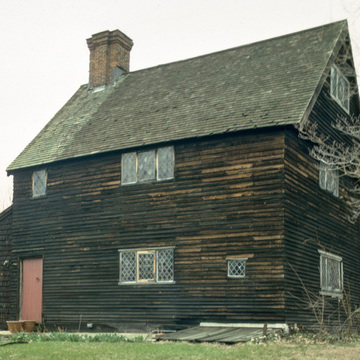Perhaps the best documented restoration by the founder of the Society for the Preservation of New England Antiquities (now Historic New England, Inc.), this colonial farmhouse was saved in 1919 by removal of a much decayed eighteenth-century south ell. This restoration returned the original south-facing one-room plan, two-story, clap-boarded house (with now lost lean-tos) to the main core, leaving the later north ell as caretaker's quarters. The present western lean-to from the first chimney bay is a nineteenth-century addition. In the rear wall of the chamber was found one of the few intact triple casement window frames to survive in situ. Horizontal sheathing on the first floor also shows the placement of asymmetrical small casements in addition to the larger triple windows of the front and end walls. Evidence of the original fireboxes allowed accurate restoration of the chimney. Although the house was conservatively framed, with plaster-covered bricks between the studs and tusk tenon floor joists, the survival of details like a proto-crown molding, the black painted band on plaster for a baseboard, and decorative hardware make the house significant. The lower cooking hall has since been furnished on the basis of late-seventeenth-century probate inventory evidence; the upper chamber remains unfurnished to show its architectural evidence. The building is open by appointment with Historic New England, Inc.
You are here
Abraham Browne House
If SAH Archipedia has been useful to you, please consider supporting it.
SAH Archipedia tells the story of the United States through its buildings, landscapes, and cities. This freely available resource empowers the public with authoritative knowledge that deepens their understanding and appreciation of the built environment. But the Society of Architectural Historians, which created SAH Archipedia with University of Virginia Press, needs your support to maintain the high-caliber research, writing, photography, cartography, editing, design, and programming that make SAH Archipedia a trusted online resource available to all who value the history of place, heritage tourism, and learning.















